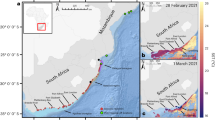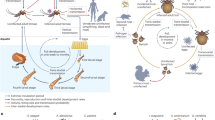Abstract
The deliberate introduction of new species can have unexpected negative consequences1,2 and we show here how a recently introduced fish, the invasive Asian cyprinid Pseudorasbora parva, is causing increased mortality and totally inhibiting spawning in an already endangered native fish, the European cyprinid Leucaspius delineatus. This threat is caused by an infectious pathogen, a rosette-like intracellular eukaryotic parasite that is a deadly, non-specific agent. It is probably carried by healthy Asian fish, and could decrease fish biodiversity in Europe, as well as having implications for commercial aquaculture.
Similar content being viewed by others
Main
The sunbleak, L. delineatus, is the only representative of its genus and the only nest-guarding fish among European cyprinids. Once widespread in Europe, in the past 40 years it has inexplicably declined3 and is now on the European list of threatened freshwater fishes3. By contrast, since its introduction in 1960 into Romanian ponds near the River Danube, the Asian topmouth gudgeon, P. parva, has spread rapidly throughout Europe4 and has locally coincided with L. delineatus extinction5,6.
In laboratory experiments (for methods, see supplementary information), we found that the holding water of P. parva acted as an absolute inhibitor of spawning for L. delineatus (no eggs produced in P. parva water compared with 1,596±840 in control, clean water), and caused a large increase in fish mortality (69±3% deaths in the treatment group, compared with 16±2% ; P<0.05, Mann-Whitney U-test; 4 experiments). These results were confirmed in a large natural outdoor pond, where L. delineatus populations declined by 96% over three spawning seasons (2002–04; Fig. 1a) after being mixed with P. parva, despite an increase of 13% in the year before P. parva arrived (2001; Fig. 1a). Spawning was totally inhibited in L. delineatus after P. parva was introduced.
a, The exact maximum likelihood estimates (red bars, showing s.e.m.) for L. delineatus populations in the autumn are shown for four years. Starting populations in April of 2001 and of 2002 are shown as blue bars: these represent 1,200 L. delineatus in 2001, and 600 L. delineatus present in a mixed population with 600 P. parva introduced in 2002. b, High-power light micrograph of a section of a L. delineatus liver. There is a focus of phagocytic cells (arrow) containing conspicuous eosinophilic rosette-like agents (pink). (Slide stained with haematoxylin and eosin; scale bar, 50 micrometres.)
We found that the decline in L. delineatus (caused by total inhibition of spawning, loss of body condition, and death) that resulted from sharing water with P. parva was caused by an infectious organism. Histological findings from moribund L. delineatus indicated extensive infection of visceral organs, including the reproductive tissues, with an obligate intracellular eukaryotic pathogen (Fig. 1b; see also supplementary information) similar to the lethal rosette agent Sphaerothecum destruens7 that infects Chinook salmon, Oncorhynchus tshawytscha, and Atlantic salmon, Salmo salar.
The presence of this pathogen in L. delineatus that had been exposed to holding water from P. parva, and its absence in the source population and in the control group (n=20), was confirmed by polymerase chain reaction amplification of its DNA using primers specific to a small segment of the ribosomal DNA of S. destruens. The prevalence of the rosette-like agent in moribund or dead L. delineatus was 67% (n=12). The parasite was also detected in subclinical fish in the treatment group, but at a lower prevalence (28%; n=32). This level of infection is consistent with that reported in tissues of salmon exposed to S. destruens8.
Preliminary examination indicates that other cyprinids, such as the fathead minnow Pimephales promelas, are also susceptible to this pathogen, which causes effects identical to those in L. delineatus (prevalence, 20%; n=5). All P. parva specimens (n=10) tested for the rosette-like agent were negative: however, this is to be expected, given that pathogen concentrations in healthy carrier fish are very low and difficult to detect using conventional diagnostic tests9. Cohabitation studies are a recognized method for detecting carrier states for different fish pathogens9,10 and, as our results illustrate, they are currently the most reliable way to detect a healthy carrier.
Our results have three important implications. First, the most invasive fish species in Europe4 is a healthy host for a deadly, non-specific pathogen that could threaten aquaculture trade, including that of salmonids. Second, it is difficult to identify fish populations that are carriers of pathogens. Third, this pathogen could pose a threat to the conservation of European fish diversity.
References
Lodge, D. M. Trends Ecol. Evol. 8, 133–137 (1993).
Van der Zanden, J. M., Casselman, J. M. & Rasmussen, J. B. Nature 401, 464–467 (1999).
Lelek, A. The Freshwater Fishes of Europe: Threatened Fishes of Europe (AULA, Wiesbaden, 1987).
Gozlan, R. E., Pinder, A. C. & Shelley, J. J. Fish Biol. 61, 298–300 (2002).
Giurca, R. & Angelescu, N. Romaniei. Bul. Cerc. Pisc. 30, 99–109 (1971).
Wolfram-Wais, A., Wolfram, G., Auer, B., Mikschi, E. & Hain, A. Hydrobiologia 409, 123–129 (1999).
Arkush, K. D., Mendoza, L., Adkinson, M. A. & Hedrick, R. P. J. Eukaryot. Microbiol. 50, 430–438 (2003).
Mendonca, H. L. & Arkush, K. D. Dis. Aquat. Org. 61, 187–197 (2004).
St-Hilaire, S., Ribble, C., Traxler, G., Davies, T. & Kent, M. L. Dis. Aquat. Org. 46, 173–179 (2001).
Gilad, O. et al. Dis. Aquat. Org. 48, 101–108 (2002).
Author information
Authors and Affiliations
Corresponding author
Ethics declarations
Competing interests
The authors declare no competing financial interests.
Supplementary information
Supplementary information
Summary of methods used for the rosette-like agent characterization. (DOC 41 kb)
Supplementary Figure S1
Experimental set-up for the cohabitation studies. (DOC 253 kb)
Supplementary Figure S2
Multifocal granulomatous lesions in the ovary of L. delineatus. (DOC 2624 kb)
Rights and permissions
About this article
Cite this article
Gozlan, R., St-Hilaire, S., Feist, S. et al. Disease threat to European fish. Nature 435, 1046 (2005). https://doi.org/10.1038/4351046a
Published:
Issue Date:
DOI: https://doi.org/10.1038/4351046a
This article is cited by
-
An overview of parasitic co-infections in tilapia culture
Aquaculture International (2023)
-
Functional feeding traits and fecundity as predictors of invasive success of the introduced Nile tilapia, Oreochromis niloticus in Lake Bosomtwe, Ghana
Biological Invasions (2023)
-
Invasive vermiculated sailfin catfish (Pterygoplichthys disjunctivus) has an impact on highly valued native fish species
Biological Invasions (2023)
-
Environmental and spatial determinants of parasite communities in invasive and native freshwater fishes
Hydrobiologia (2022)
-
Highly sensitive environmental DNA detection of topmouth gudgeon, Pseudorasbora parva: a comparison of qPCR and microfluidic qdPCR
Biological Invasions (2022)
Comments
By submitting a comment you agree to abide by our Terms and Community Guidelines. If you find something abusive or that does not comply with our terms or guidelines please flag it as inappropriate.




